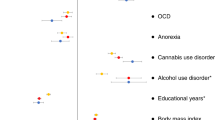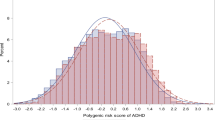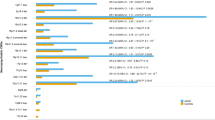Abstract
Recent studies report association and linkage between attention deficit hyperactivity disorder (ADHD) and the 7-repeat allele of a 48 base-pair repeat in the dopamine D4 receptor gene (DRD4).1 We examined the frequency of this allele in a sample of probands with DSM-IV ADHD using a case-control design, as well as the transmission disequilibrium test (TDT) and haplotype-based haplotype relative risk (HHRR) in the subset of probands with DNA available from both parents. One hundred and thirty-two ADHD probands were compared with 189 controls (χ2 = 6.17, 1 df, P = 0.01, OR = 1.73, 95% CI = 1.11–2.71). A total of 85 complete trios were available for within-family tests of association and linkage. Fifty-two heterozygous parents carrying one copy of the 7-repeat were informative for the TDT (29 transmitted vs 23 non-transmitted, χ2 = 0.69). Analysis of the entire sample of 132 probands using TRANSMIT2 provided no additional evidence for excess transmission of the 7-repeat allele (58 transmitted vs 54 non-transmitted). HHRR gave similar results. We conclude that the case-control findings are likely to be falsely positive, resulting from genetic stratification. However we can not rule out alternative explanations of low statistical power and gene–environment correlation.
This is a preview of subscription content, access via your institution
Access options
Subscribe to this journal
Receive 12 print issues and online access
$259.00 per year
only $21.58 per issue
Buy this article
- Purchase on Springer Link
- Instant access to full article PDF
Prices may be subject to local taxes which are calculated during checkout
Similar content being viewed by others
References
Collier DA, Curran S, Asherson P . Mission: not impossible? Candidate gene studies in child psychiatric disorders Mol Psychiatry 2000 5: 457–460
Clayton DG . A generalization of the transmission/disequilibrium test for uncertain-haplotype transmission Am J Hum Genet 1999 65: 1170–1177
Faraone SV, Biederman J, Weiffenbach B, Keith T, Chu MP, Weaver A et al. Dopamine D4 gene 7-repeat allele and attention deficit hyperactivity disorder Am J Psychiatry 1999 156: 768–770
Swanson JM, Sunohara GA, Kennedy JL, Regino R, Fineberg E, Wigal T et al. Association of the dopamine receptor D4 (DRD4) gene with a refined phenotype of attention deficit hyperactivity disorder (ADHD): a family-based approach Mol Psychiatry 1998 3: 38–41
Smalley SL, Bailey JN, Palmer CG, Cantwell DP, McGough JJ, Del'Homme MA et al. Evidence that the dopamine D4 receptor is a susceptibility gene in attention deficit hyperactivity disorder Mol Psychiatry 1998 3: 427–430
Rowe DC, Stever C, Giedinghagen LN, Gard JM, Cleveland HH, Terris ST et al. Dopamine DRD4 receptor polymorphism and attention deficit hyperactivity disorder Mol Psychiatry 1998 3: 419–426
LaHoste GJ, Swanson JM, Wigal SB, Glabe C, Wigal T, King N et al. Dopamine D4 receptor gene polymorphism is associated with attention deficit hyperactivity disorder Mol Psychiatry 1996 1: 121–124
Tahir E, Yazgan Y, Cirakoglu B, Ozbay F, Waldman I, Asherson PJ . Association and linkage of DRD4 and DRD5 with attention deficit hyperactivity disorder (ADHD) in a sample of Turkish children Mol Psychiatry 2000 5: 396–404
Muglia P, Jain U, Macciardi F, Kennedy JL . Adult attention deficit hyperactivity disorder and the dopamine D4 receptor gene Am J Med Genet 2000 96: 273–277
Sunohara GA, Roberts W, Malone M, Schachar R, Tannock R, Basile V et al. Linkage of the dopamine D4 receptor gene and attention-deficit hyperactivity disorder (in press)
Holmes J, Payton A, Barrett JH, Hever T, Fitzpatrick H, Trumper AL . et al. A family-based and case control association study of the dopamine D4 receptor gene and dopamine transporter gene in attention deficit hyperactivity disorder Mol Psychiatry 2000 5: 523–530
Castellanos FX, Lau E, Tayebi N, Lee P, Long RE, Giedd JN et al. Lack of an association between a dopamine-4 receptor polymorphism and attention-deficit/hyperactivity disorder: genetic and brain morphometric analyses Mol Psychiatry 1998 3: 431–434
Hawi Z, McCarron M, Kirley A, Daly G, Fitzgerald M, Gill M . No association of the dopamine DRD4 receptor (DRD4) gene polymorphism with attention deficit hyperactivity disorder (ADHD) in the Irish population Am J Med Genet 2000 96: 268–272
Eisenberg J, Zohar A, Mei-Tal G, Steinberg A, Tartakovsky E, Gritsenko I et al. A haplotype relative risk study of the dopamine D4 receptor (DRD4) exon III repeat polymorphism and attention deficit hyperactivity disorder (ADHD) Am J Med Genet 2000 96: 258–261
Kotler M, Manor I, Sever Y, Eisenberg J, Cohen H, Ebstein RP et al. Failure to replicate an excess of the long dopamine D4 exon III repeat polymorphism in ADHD in a family-based study Am J Med Genet 2000 96: 278–281
Faraone SV, Doyle AE, Mick E, Biederman J . Meta-analysis of the association between the dopamine D4 gene 7-repeat allele and attention deficit hyperactivity disorder (in press)
Lim LCC, Nothen MM, Korner J, Rietschel M, Castle D, Hunt N et al. No evidence of association between dopamine D4 receptor variants and bipolar affective disorder Am J Med Genet 1994 54: 259–263
Daniels J, Williams J, Mant R, Asherson P, McGuffin P, Owen MJ . Repeat length variation in the dopamine D4 receptor gene shows no evidence of association with schizophrenia Am J Med Genet 1994 54: 256–258
Pritchard JK, Stephens M, Rosenberg AN, Connelly P . Association mapping in structured populations Am J Hum Genet 2000 67: 170–181
Lander E, Kruglyak L . Genetic dissection of complex traits: guidelines for interpreting and reporting linkage results Nature Genet 1995 11: 241–247
Asghari V, Sanyal S, Buchwaldt S, Paterson A, Jovanovic V, Van Tol HH . Modulation of intracellular cyclic AMP levels by different human dopamine D4 receptor variants J Neurochem 1995 65: 1157–1165
Kazmi MA, Snyder LA, Cypess AM, Graber SG, Sakmar TP . Selective reconstitution of human D4 dopamine receptor variants with Gi alpha subtypes Biochemistry 2000 39: 3734–3744
Watts VJ, Vu MN, Wiens BL, Jovanovic V, Van Tol HH, Neve KA . S Psychopharmacology (Berl) 1999 141: 83–92
Jovanovic V, Guan HC, Van Tol HH . Comparative pharmacological and functional analysis of the human dopamine D4.2 and D4.10 receptor variants Pharmacogenetics 1999 9: 561–568
Okuyama Y, Ishiguro H, Nankai M, Shibuya H, Watanabe A, Arinami T . Identification of a polymorphism in the promoter region of DRD4 associated with the human novelty seeking personality trait Mol Psychiatry 2000 5: 64–69
Angold A, Costello E . A test-retest reliability study of child-reported psychiatric symptoms and diagnoses using the Child and Adolescent Psychiatric Assessment (CAPA-C) Psychol Med 1995 25: 755–762
Conners CK . The Conners rating scales: instruments for the assessments of childhood psychopathology Duke University 1995
Curran S, Newman S, Taylor E, Asherson P . Hypescheme: an operational criteria checklist and minimum data set for molecular genetic studies of attention deficit and hyperactivity disorders Am J Med Genet 2000 96: 244–250
Berument SK, Rutter M, Lord C, Pickles A, Bailey A . Autism screening questionnaire: diagnostic validity Br J Psychiatry 1999 175: 444–451
Goodman R . The strengths and difficulties questionnaire: a research note J Child Psychol Psychiatry & Appl Discip 1997 38: 581–586
Acknowledgements
This research was funded by a Medical Research Council (MRC) component grant to the Social Genetic Developmental Psychiatry Research Centre. Control samples were collected with funds from a Wellcome Training Fellowship to SC and UB samples were collected with funds from a Wellcome Training Fellowship to LK. JM is an MRC PhD student. We wish to thank all clinicians and families who helped in this research. Particular thanks go to Dr Geof Kewley, Dr Mark Berelowitz, Professor Peter Hill, Fiona McNicholas, Mary Cameron and Saama El Abd.
Author information
Authors and Affiliations
Corresponding author
Rights and permissions
About this article
Cite this article
Mill, J., Curran, S., Kent, L. et al. Attention deficit hyperactivity disorder (ADHD) and the dopamine D4 receptor gene: evidence of association but no linkage in a UK sample. Mol Psychiatry 6, 440–444 (2001). https://doi.org/10.1038/sj.mp.4000881
Received:
Revised:
Accepted:
Published:
Issue Date:
DOI: https://doi.org/10.1038/sj.mp.4000881
Keywords
This article is cited by
-
Dopamine Receptor Expression and the Pathogenesis of Attention-Deficit Hyperactivity Disorder: a Scoping Review of the Literature
Current Developmental Disorders Reports (2022)
-
Role of Dopamine Receptors in ADHD: A Systematic Meta-analysis
Molecular Neurobiology (2012)
-
Candidate gene studies of ADHD: a meta-analytic review
Human Genetics (2009)
-
No evidence for the association of DRD4 with ADHD in a Taiwanese population within-family study
BMC Medical Genetics (2005)
-
Childhood Inattention and Dysphoria and Adult Obesity Associated with the Dopamine D4 receptor Gene in Overeating Women with Seasonal Affective Disorder
Neuropsychopharmacology (2004)



